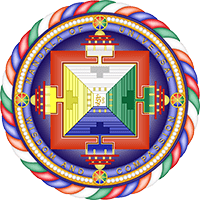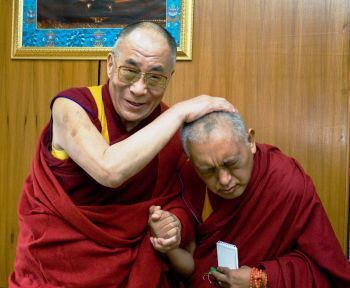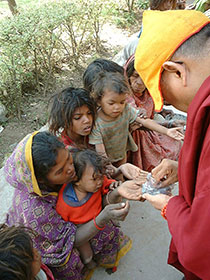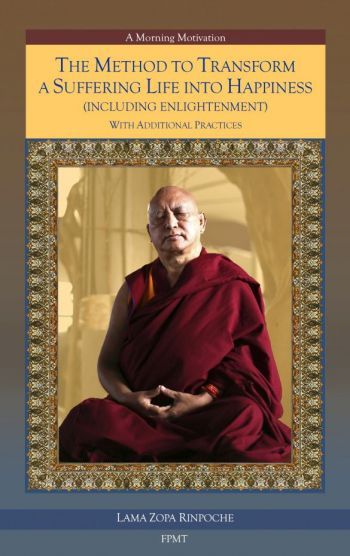- Home
- FPMT Homepage
Foundation for the Preservation of the Mahayana Tradition
The FPMT is an organization devoted to preserving and spreading Mahayana Buddhism worldwide by creating opportunities to listen, reflect, meditate, practice and actualize the unmistaken teachings of the Buddha and based on that experience spreading the Dharma to sentient beings. We provide integrated education through which people’s minds and hearts can be transformed into their highest potential for the benefit of others, inspired by an attitude of universal responsibility and service. We are committed to creating harmonious environments and helping all beings develop their full potential of infinite wisdom and compassion. Our organization is based on the Buddhist tradition of Lama Tsongkhapa of Tibet as taught to us by our founders Lama Thubten Yeshe and Lama Thubten Zopa Rinpoche.
- Willkommen
Die Stiftung zur Erhaltung der Mahayana Tradition (FPMT) ist eine Organisation, die sich weltweit für die Erhaltung und Verbreitung des Mahayana-Buddhismus einsetzt, indem sie Möglichkeiten schafft, den makellosen Lehren des Buddha zuzuhören, über sie zur reflektieren und zu meditieren und auf der Grundlage dieser Erfahrung das Dharma unter den Lebewesen zu verbreiten.
Wir bieten integrierte Schulungswege an, durch denen der Geist und das Herz der Menschen in ihr höchstes Potential verwandelt werden zum Wohl der anderen – inspiriert durch eine Haltung der universellen Verantwortung und dem Wunsch zu dienen. Wir haben uns verpflichtet, harmonische Umgebungen zu schaffen und allen Wesen zu helfen, ihr volles Potenzial unendlicher Weisheit und grenzenlosen Mitgefühls zu verwirklichen.
Unsere Organisation basiert auf der buddhistischen Tradition von Lama Tsongkhapa von Tibet, so wie sie uns von unseren Gründern Lama Thubten Yeshe und Lama Thubten Zopa Rinpoche gelehrt wird.
- Bienvenidos
La Fundación para la preservación de la tradición Mahayana (FPMT) es una organización que se dedica a preservar y difundir el budismo Mahayana en todo el mundo, creando oportunidades para escuchar, reflexionar, meditar, practicar y actualizar las enseñanzas inconfundibles de Buda y en base a esa experiencia difundir el Dharma a los seres.
Proporcionamos una educación integrada a través de la cual las mentes y los corazones de las personas se pueden transformar en su mayor potencial para el beneficio de los demás, inspirados por una actitud de responsabilidad y servicio universales. Estamos comprometidos a crear ambientes armoniosos y ayudar a todos los seres a desarrollar todo su potencial de infinita sabiduría y compasión.
Nuestra organización se basa en la tradición budista de Lama Tsongkhapa del Tíbet como nos lo enseñaron nuestros fundadores Lama Thubten Yeshe y Lama Zopa Rinpoche.
A continuación puede ver una lista de los centros y sus páginas web en su lengua preferida.
- Bienvenue
L’organisation de la FPMT a pour vocation la préservation et la diffusion du bouddhisme du mahayana dans le monde entier. Elle offre l’opportunité d’écouter, de réfléchir, de méditer, de pratiquer et de réaliser les enseignements excellents du Bouddha, pour ensuite transmettre le Dharma à tous les êtres. Nous proposons une formation intégrée grâce à laquelle le cœur et l’esprit de chacun peuvent accomplir leur potentiel le plus élevé pour le bien d’autrui, inspirés par le sens du service et une responsabilité universelle. Nous nous engageons à créer un environnement harmonieux et à aider tous les êtres à épanouir leur potentiel illimité de compassion et de sagesse. Notre organisation s’appuie sur la tradition guéloukpa de Lama Tsongkhapa du Tibet, telle qu’elle a été enseignée par nos fondateurs Lama Thoubtèn Yéshé et Lama Zopa Rinpoché.
Visitez le site de notre Editions Mahayana pour les traductions, conseils et nouvelles du Bureau international en français.
Voici une liste de centres et de leurs sites dans votre langue préférée
- Benvenuto
L’FPMT è un organizzazione il cui scopo è preservare e diffondere il Buddhismo Mahayana nel mondo, creando occasioni di ascolto, riflessione, meditazione e pratica dei perfetti insegnamenti del Buddha, al fine di attualizzare e diffondere il Dharma fra tutti gli esseri senzienti.
Offriamo un’educazione integrata, che può trasformare la mente e i cuori delle persone nel loro massimo potenziale, per il beneficio di tutti gli esseri, ispirati da un’attitudine di responsabilità universale e di servizio.
Il nostro obiettivo è quello di creare contesti armoniosi e aiutare tutti gli esseri a sviluppare in modo completo le proprie potenzialità di infinita saggezza e compassione.
La nostra organizzazione si basa sulla tradizione buddhista di Lama Tsongkhapa del Tibet, così come ci è stata insegnata dai nostri fondatori Lama Thubten Yeshe e Lama Zopa Rinpoche.
Di seguito potete trovare un elenco dei centri e dei loro siti nella lingua da voi prescelta.
- 欢迎 / 歡迎
简体中文
“护持大乘法脉基金会”( 英文简称:FPMT。全名:Foundation for the Preservation of the Mahayana Tradition) 是一个致力于护持和弘扬大乘佛法的国际佛教组织。我们提供听闻,思维,禅修,修行和实证佛陀无误教法的机会,以便让一切众生都能够享受佛法的指引和滋润。
我们全力创造和谐融洽的环境, 为人们提供解行并重的完整佛法教育,以便启发内在的环宇悲心及责任心,并开发内心所蕴藏的巨大潜能 — 无限的智慧与悲心 — 以便利益和服务一切有情。
FPMT的创办人是图腾耶喜喇嘛和喇嘛梭巴仁波切。我们所修习的是由两位上师所教导的,西藏喀巴大师的佛法传承。
繁體中文
護持大乘法脈基金會”( 英文簡稱:FPMT。全名:Found
ation for the Preservation of the Mahayana Tradition ) 是一個致力於護持和弘揚大乘佛法的國際佛教組織。我們提供聽聞, 思維,禪修,修行和實證佛陀無誤教法的機會,以便讓一切眾生都能 夠享受佛法的指引和滋潤。 我們全力創造和諧融洽的環境,
為人們提供解行並重的完整佛法教育,以便啟發內在的環宇悲心及責 任心,並開發內心所蘊藏的巨大潛能 — 無限的智慧與悲心 – – 以便利益和服務一切有情。 FPMT的創辦人是圖騰耶喜喇嘛和喇嘛梭巴仁波切。
我們所修習的是由兩位上師所教導的,西藏喀巴大師的佛法傳承。 察看道场信息:
- FPMT Homepage
- News/Media
-
- Study & Practice
-
-
- About FPMT Education Services
- Latest News
- Programs
- New to Buddhism?
- Buddhist Mind Science: Activating Your Potential
- Heart Advice for Death and Dying
- Discovering Buddhism
- Living in the Path
- Exploring Buddhism
- FPMT Basic Program
- FPMT Masters Program
- FPMT In-Depth Meditation Training
- Maitripa College
- Lotsawa Rinchen Zangpo Translator Program
- Universal Education for Compassion & Wisdom
- Online Learning Center
-
- Prayers & Practice Materials
- Overview of Prayers & Practices
- Full Catalogue of Prayers & Practice Materials
- Explore Popular Topics
- Benefiting Animals
- Chenrezig Resources
- Death & Dying Resources
- Lama Chopa (Guru Puja)
- Lama Zopa Rinpoche: Compendium of Precious Instructions
- Lama Zopa Rinpoche: Life Practice Advice
- Lama Zopa Rinpoche Practice Series
- Lamrim Resources
- Mantras
- Prayer Book Updates
- Purification Practices
- Sutras
- Thought Transformation (Lojong)
- Audio Materials
- Dharma Dates - Tibetan Calendar
- Translation Services
- Publishing Services
- Ways to Offer Support
- Prayers & Practice Materials
-
- Teachings and Advice
- Find Teachings and Advice
- Lama Zopa Rinpoche Advice Page
- Lama Zopa Rinpoche: Compendium of Precious Instructions
- Lama Zopa Rinpoche Video Teachings
- ༧སྐྱབས་རྗེ་བཟོད་པ་རིན་པོ་ཆེ་མཆོག་ནས་སྩལ་བའི་བཀའ་སློབ་བརྙན་འཕྲིན།
- Podcasts
- Lama Yeshe Wisdom Archive
- Buddhism FAQ
- Dharma for Young People
- Resources on Holy Objects
- Teachings and Advice
-
-
*If a menu item has a submenu clicking once will expand the menu clicking twice will open the page.
-
-
- Centers
-
- Teachers
-
- Projects
-
-
-
-
*If a menu item has a submenu clicking once will expand the menu clicking twice will open the page.
-
-
- FPMT
-
-
-
-
-
No matter whether you are a believer or a non-believer, religious or not religious, a Christian, Hindu, or a scientist, black or white, an Easterner or a Westerner, the most important thing to know is your own mind and how it works.
Lama Thubten Yeshe
-
-
-
- Shop
-
-
-
The Foundation Store is FPMT’s online shop and features a vast selection of Buddhist study and practice materials written or recommended by our lineage gurus. These items include homestudy programs, prayers and practices in PDF or eBook format, materials for children, and other resources to support practitioners.
Items displayed in the shop are made available for Dharma practice and educational purposes, and never for the purpose of profiting from their sale. Please read FPMT Foundation Store Policy Regarding Dharma Items for more information.
-
-
Lama Yeshe’s Wisdom
24
Lama Yeshe on Christmas: Timeless Teaching and Video

Portrait of Lama Yeshe, Manjushri Institute, England,1982. Photo courtesy of the Lama Yeshe Wisdom Archive.
Around Christmas time between 1971 and 1975, Lama Yeshe gave several talks related to Christmas to the Western students at Kopan Monastery, Nepal, in case some of them were missing their families and being at home at that festive time of year. These talks, and another given on Christmas Day, 1982, at Istituto Lama Tzong Khapa during Lama’s teachings on the Six Yogas of Naropa, have been collected into the book Silent Mind Holy Mind.
As is our custom this time of year, we share an excerpt from Silent Mind, Holy Mind. Please enjoy this timeliness teaching from Lama Yeshe on the subject of Giving.
Reflections on Christmas
By Lama Yeshe
This is the week of Holy Jesus’s birth, and I suggest that in honor of this special event we make some sort of celebration. But we should try to make it meaningful. It should not be some kind of physical sensation, bringing only more confusion and superstition to our mind.
For a Christmas celebration to be a good one, it must be of a truly religious nature. Jesus came to this Earth and presented his teachings, but worldly beings completely disregard this fact. For them Christmas means— first and foremost—shopping, spending money, buying presents and creating confusion. Such confusion is entirely of our own making. We have the power to make Christmas meaningful, peaceful and truly religious, but instead of using this power we succumb to worldly negative energy. We go shopping to buy presents, but generally this is not done with anything even resembling a loving attitude. We think, “I really must buy something for my sister because if I don’t give her anything, maybe she won’t like me anymore. Maybe she won’t give me anything either.” Or, “I better not get my friend a cheap present or I might not get anything valuable back from him next year.” Such thoughts are extremely negative, leading to nothing but further dissatisfaction. They are totally involved with egotistic and immature notions about what true happiness is. They have nothing whatsoever to do with religion.
True religion brings peace and satisfaction to the mind. Actions that arouse only confusion serve no religious function at all. They stem instead from a political mind that thinks, “If I give this, I’ll get that in return.” Such a mind is extremely immature and selfish. It delights when many presents are received and is depressed when expectations go unfulfilled. What difference, then, is there between such a mind and that of a small child? We consider ourselves to be grown up, but our actions and attitudes show us to be little different from our children. They exaggerate the importance of receiving gifts, and so do we. In fact, their exaggerated expectations—their mind of confusion and dissatisfaction—develops largely from watching us.
If we were to act in a consistently mature and meaningful way, our children would also become peaceful. We sometimes think that they are naturally berserk and that we are something special, but this is not so. Check up and see exactly what happens when a holiday approaches. We are the ones who create the commotion. The first thing that happens at the beginning of a holiday is that husband and wife, uncle and aunt and so forth begin to fight with one another. Can you imagine that? Be honest and investigate the truth of this. And nearly all their fights are over material possessions. This is especially true at Christmas time. I am not trying to be excessively negative; just check up and see if this is true or not. Holiday bickering has so much jealousy in it: “Let me see, what did you get? What did he get?” Such a dualistic mind is totally submerged in selfishness and wrong conceptions.
This deluded type of behavior is not common merely to one culture. It can be found everywhere. Similarly, the antidote to this confusion is not taught merely in Buddhism. All religions strive to counter unsatisfactory, confused attitudes and bring us peace of mind. Please continue to read the full teaching as well as a lively question and answer session!
The 2024 edition of Silent Mind Holy Mind has been expanded to include the original collection of talks given by Lama Yeshe at Kopan Monastery on Christmas Eve, as well as another Christmas talk and a Cistercian priest’s tribute to Lama after he passed away in 1984. Edited by Jon Landaw and Nicholas Ribush. Go to the Contents page to find links to these teachings on the LYWA website. You can also download a free PDF file.
We are also happy to share a video of Lama Yeshe offering a Christmas teaching in1982 at Istituto Lama Tzong Khapa in Pomaia, Italy:
Foundation for the Preservation of Mahayana Tradition (FPMT), is a Tibetan Buddhist organization dedicated to the transmission of the Mahayana Buddhist tradition and values worldwide through teaching, meditation and community service.
- Tagged: christmas, silent mind holy mind
18
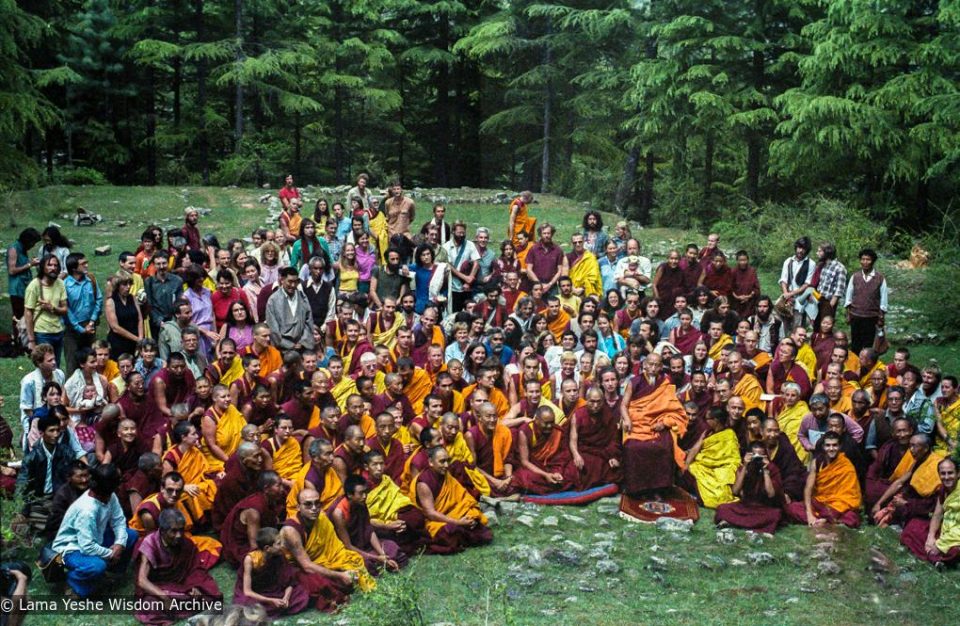
First Enlightened Experience Celebration group with Zong Rinpoche, back of Tushita Retreat Centre, Dharamsala, India, 1982. Photo courtesy of the Lama Yeshe Wisdom Archive.
In 1982, FPMT hosted its first Enlightened Experience Celebration, (EEC1) which was held in India from January to June 1982, and hosted by International Mahayana Institute. The purpose of the first EEC was to gather students of Lama Yeshe and Lama Zopa Rinpoche, especially the Western monks and nuns, to strengthen the presence of Buddhism in the West and facilitate the ongoing transmission of the Dharma into Western culture.
EEC2 (the second EEC) was originally scheduled for 1984-85, but was postponed due to the passing of Lama Yeshe and changed to November 1985–February 1986 and took place in Nepal and India. A third EEC included a series of discourses given by Lama Zopa Rinpoche in Bodhgaya, India, from February 16–25, 1990. FPMT Mongolia hosted a fourth EEC in 2004.
Today we are sharing two precious videos from EEC1. These videos capture so deeply the warmth and care offered by these two extraordinary lamas.
We are so fortunate to have this video (filmed by long-time FPMT student Robyn Brentano) of Lama Yeshe offering blessing strings to Western students at the end of teachings on Mahamudra by His Holiness the Dalai Lama during the EEC1 in Dharamsala, India, March 1982. It is easy to observe the personal way Lama engaged with each student, offering such kindness.
Robyn Brentano also interviewed Lama Zopa Rinpoche during EEC1 1982. In this video, Rinpoche joyfully gives intimate meditation advice for beginning Buddhists, explains emptiness in detail, and describes what happens when the object of emptiness is mistaken or rejected:
As is often the case with the early students of FPMT and the Lamas, the interviewer in these two videos, Robyn Brentano, has a remarkable story to share! Please read Robyn’s account of how she ended up filming the events of EEC1 in 1982.
Filming the First Enlightened Experience Celebration
By Robyn Brentano
I met Lama Yeshe and Kyabje Lama Zopa Rinpoche in 1975 when I ended up living in Boudha and stayed for the 8th Kopan Course. Needless to say, that experience completely turned my life around. After I reconnected with Lama and Rinpoche at the Kalachakra in Madison in ’81, I decided to quit my job in New York City (Executive Director for the Dia Art Foundation’s Whitman Project) and go to India for the Enlightened Experience Celebration.
I was a performer and producer in the avant garde dance/theater and art world in NYC from 1968-1981 and had directed several experimental 16mm dance films and videos in the 70s-early 80s. Soon after the EEC1 began in Bodh Gaya, someone gave Lama Yeshe a Super8 camera to document the EEC. He found out that I was a filmmaker, so he asked if I could help film the events. He also asked Roland Stutz to help so we teamed up and worked together on shooting key activities.
When we got to Dharamsala, someone gave Lama a VHS camera, which meant that we had much more latitude to shoot longer sequences. I also took on the task of video recording His Holiness the Dalai Lama’s teaching on Mahamudra, which was quite challenging technically. There are photos of all the FPMT Sangha in the temple at His Holiness’s teaching and I can be seen sitting behind the camera.
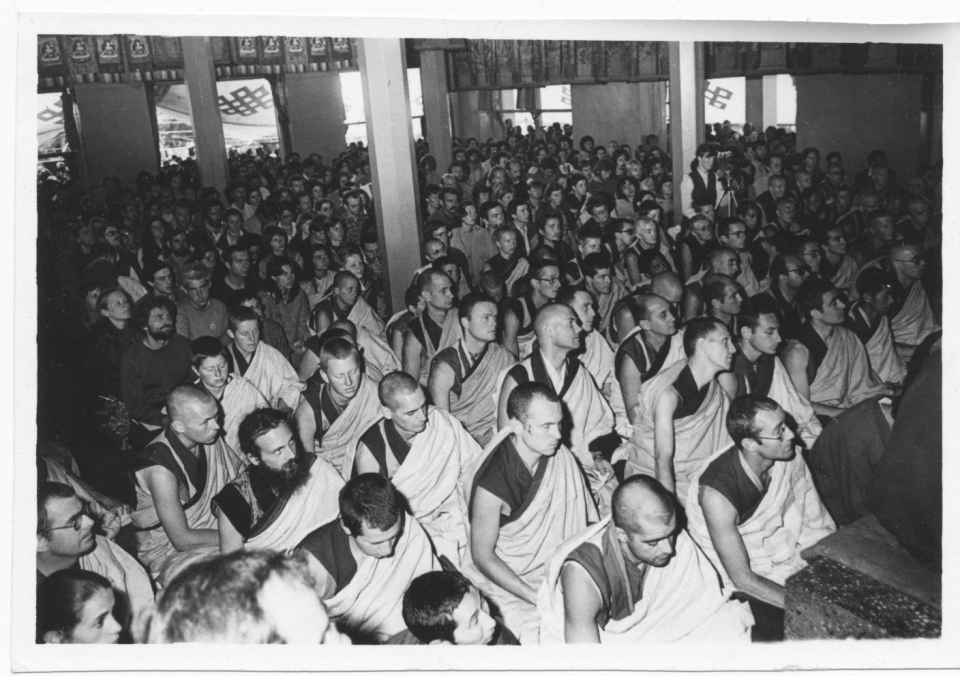
FPMT Sangha during His Holiness the Dalai Lama’s teachings on Mahamudra, March 1982. Robyn Brentano can be seen behind the camera near the pillar in the upper right. Photographer unknown. photo courtesy of Robyn Brentano.
One day when we were all up at Tushita, Lama asked me to interview Rinpoche. As I remember it, there was no time to prepare. I think I asked him what I should ask Rinpoche and he just said something like “Don’t worry dear, just ask him how it is he doesn’t sleep.” I was a relatively new Dharma student and didn’t have a clue what questions to raise. Rinpoche, of course, was so kind and gave that amazing teaching on emptiness.
With grateful thanks to Robyn for sharing some of this precious history with us!
All are welcome to access additional teachings and videos from EEC1 from the Lama Yeshe Wisdom Archive.
Foundation for the Preservation of Mahayana Tradition (FPMT), is a Tibetan Buddhist organization dedicated to the transmission of the Mahayana Buddhist tradition and values worldwide through teaching, meditation and community service.
- Tagged: eec1, enlightened experience celebration
5
Lama Yeshe’s Wisdom: The Enlightenment Attitude
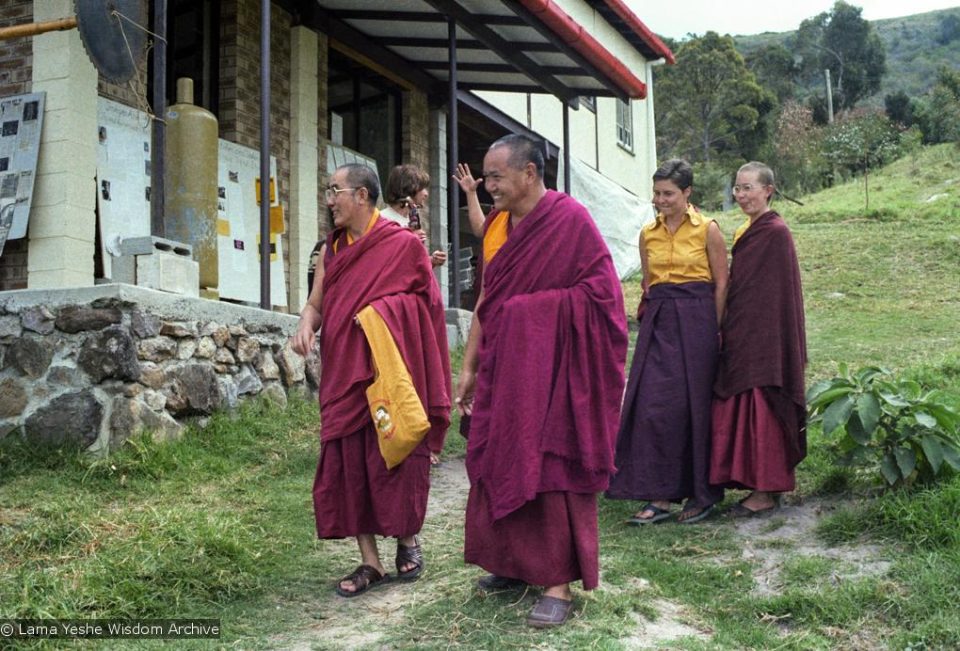
Lama Yeshe at Chenrezig Institute, Australia, 1979, with Geshe Loden on left, Vens Yeshe Khadro and Karin Valham on the right. Photo courtesy of the Lama Yeshe Wisdom Archive.
Lama Yeshe offered this teaching about the importance of bodhicitta and the mind of enlightenment when he was bestowing bodhisattva vows at Chenrezig Institute, Australia, on September 14, 1979. This discourse is now published in the LYWA book Knowledge-Wisdom: The Peaceful Path the Liberation, edited by Nicholas Ribush:
The thing is, from the Buddhist point of view, it is very important for one to have the enlightenment attitude. It is an important thing. The reason is, I think I can say, that without some kind of attitude or thought with which to transform the actions of our daily life, life seems to be a disaster. If you are living in a couple relationship, or even if you are just a single person, you still have to relate with human beings. Even if you go into the Himalaya Mountains, you still have to relate with sentient beings, human beings. There is no place that you can go where you don’t have to relate with human beings, so it is very important to have this attitude, because all actions, both good and bad, depend on it. You know—I’m not going to tell you that; you know already. So in order to transform our lives, to live in the best way, we desperately need to constantly have the divine quality enlightenment attitude, bodhicitta.
Otherwise, you can see how, in the West, people dedicate their entire lives, or most of their lives, totally to sense pleasure. Can you imagine? It is obvious why human beings in the West are easily depressed and kill themselves—it is because their purpose, goal or destination in life is so narrow: “If this man or lady cannot give me satisfaction, there is nothing worthwhile in this earth.” Can you imagine that? This is their life; this is their life. It is a completely cold, narrow mind. They particularly mention, “This lady, this man does not give me satisfaction, therefore I’m not worthwhile.” It just isn’t true. There are so many millions of ladies and gentlemen who have such a neurotic attitude, such a wrong view, so fanatical, such a self-cherishing thought, not seeing beyond the limitation. You can see. Their lives are so empty, so empty.
So you see, in the West, it’s unbelievable. They try so hard to make themselves happy by arranging their material possessions into different perspectives. “Maybe if I put it this way, something interesting; maybe I put this way, something interesting; maybe I put this way, something interesting; maybe I put this way, something interesting; maybe if I put this way, something interesting.” [Lama turns his body in all different directions.] All those things are not true—can you imagine? This way, this way or that way—what difference does it make? I mean, of course, relatively there is some difference, but that doesn’t make you satisfied, does it? Yet they try so hard; unbelievable.
It is very good to see the reality of Western life, or the Western way of living life, to check up historically. If you do, you will really get a bit of a hard shock, I tell you. It is not happy, Western life is definitely not a happy life, I can say. I’m sorry. Even though you think your life is happy, it’s not true. I’m not saying that I have investigated each individual and discovered that each one is unhappy. I am not saying that. But I am just looking at it sort of generally. It is a very difficult life. And also, people in Western samsara have some kind of instinctive attitude. I don’t know, perhaps I can say instinctive—there is no checking, no observation. They just do things, just spinning, just doing things instinctively, instinctively, spinning themselves. This makes me so afraid. No observation, no checking what’s going on. That’s dangerous.
I can see when Western people start to meditate, when they begin to observe their attitude, then they can see, “What has been happening to me?” At some point they really become crazy. Why? Because before they were just going round and round like this, then suddenly [Lama circles his finger round and round in the air and suddenly brings it up to his eyes indicating that people first circle around until they suddenly see themselves for the first time], pam! So their nervous system is shocked. Then, instead of meditation making them better, they get worse. But it is much better to question for a minute and then rest, rather than just spinning around. That way you do not become worse.
Therefore, it is good to learn how to change one’s instinctive behavior in order to transform the Western life. It is the instinctive attitude that leads to certain actions; any movements of the body and speech result from attitudes of the mind. And in order to transform that, you need quite a lot of effort, observation and penetration on the motivation. Please continue to read the entire teaching.
Excerpted from a talk given by Lama Yeshe at Chenrezig Institute, Australia, on September 14, 1979. Published in Knowledge-Wisdom: The Peaceful Path the Liberation,
Subscribe to the LYWA newsletter to keep up with the latest news and publication information.
Foundation for the Preservation of Mahayana Tradition (FPMT), is a Tibetan Buddhist organization dedicated to the transmission of the Mahayana Buddhist tradition and values worldwide through teaching, meditation and community service.
- Tagged: advice from lama yeshe, lama yeshe
18
Lama Yeshe’s Wisdom: The Peaceful Path to Liberation
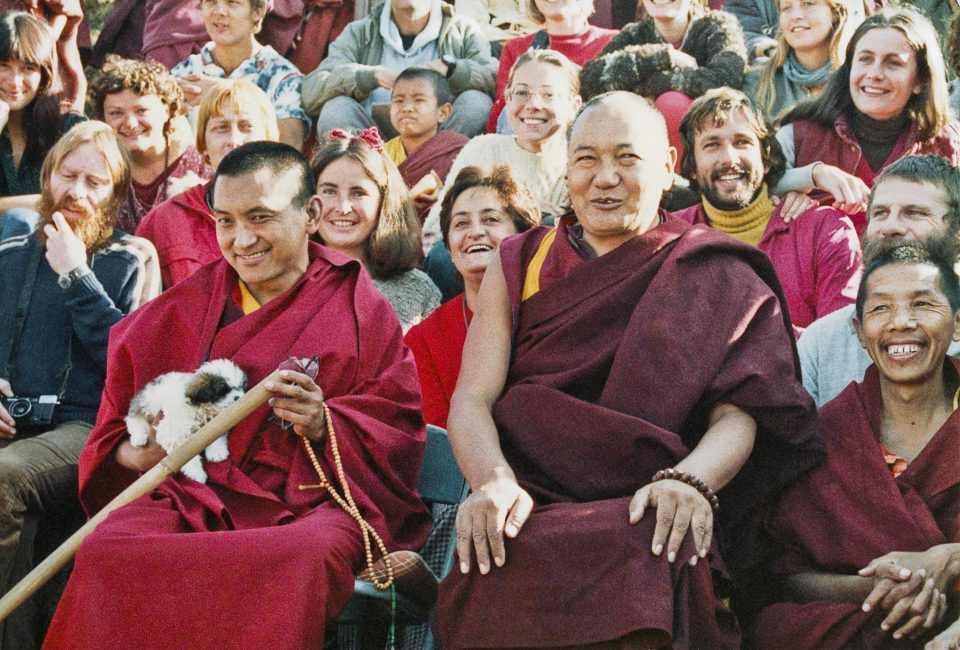
Lama Zopa Rinpoche and Lama Yeshe in group photo for the 16th Kopan Meditation Course, Fall, Kopan Monastery, Nepal, 1983. Photo courtesy LYWA.
Lama Yeshe gave a teaching on refuge, the five lay precepts, the bodhisattva vows and more on December 9, 1983, during the Sixteenth Kopan Meditation Course held at Kopan Monastery, Nepal. This was one of Lama’s last teachings before he passed away in March 1984. Edited by Uldis Balodis. This teaching is now published in the LYWA book: Knowledge-Wisdom: The Peaceful Path to Liberation. Please enjoy an excerpt from this teaching:
Taking refuge is actually very important. Anyway, we do take refuge—in food, clothes, friends and security. We try to be secure, to make life comfortable—this is taking refuge. Even mosquitoes and chicken take refuge. Refuge is not something new. I want you to know this clean-clearly. Even when we are babies we cry: “Ehhhhhh! I want milk; I want milk, Mama!” The baby doesn’t say “milk,” but the “ehhhhhh,” cry is itself the asking for milk and saying, “I’m thirsty.” Everything that we try to do physically or mentally is an expression of trying to take refuge. That’s why taking refuge is not a new thing. It’s important to know that taking refuge is not something new; it’s our trip. We do everything to try to make ourselves happy.
In an industrialized country we take everything—the minerals of the earth, everything—don’t we? This is taking refuge. Those big companies digging for oil are taking refuge, aren’t they? You know what I mean—to make a better world, they say. Maybe it’s true to some extent. All of you appeared here like mushrooms, coming by plane. Maybe those companies worked hard and did research. Anyway, we mean well; everybody means well. We take refuge to make life better, more comfortable, richer or whatever.
I agree we human beings need comfort; I agree we need a peaceful and healthy body. There’s no disagreement with the Western philosophy of having a healthy body; we agree. However, if we take refuge only in a healthy body and forget about a healthy mind, that is unfortunate, because we are forgetting the principal thing, or nucleus of life and we are just trying to do something unimportant, secondary. We should try to put effort into the important things. The Buddhist point of view is that the mind is the most important thing so that whether we are healthy or sick physically, our mind will be healthy and happy. The mind is the most important thing in order to have clarity and satisfaction, because the mind is what has the experience of misery or happiness. That’s why taking refuge in a temporary object is alright; taking the right food and right medicine for our body is important. Please continue to read the entire teaching.
Excerpted from a talk given by Lama Yeshe on December 9, 1983 at Kopan Monastery, Nepal, and published in Knowledge-Wisdom: The Peaceful Path to Liberation.
Subscribe to the LYWA monthly e-letter and keep up with the latest news and publication information.
Foundation for the Preservation of Mahayana Tradition (FPMT), is a Tibetan Buddhist organization dedicated to the transmission of the Mahayana Buddhist tradition and values worldwide through teaching, meditation and community service.
- Tagged: advice from lama yeshe, lama yeshe
10
Lama Yeshe’s Wisdom: Refuge is a State of Mind
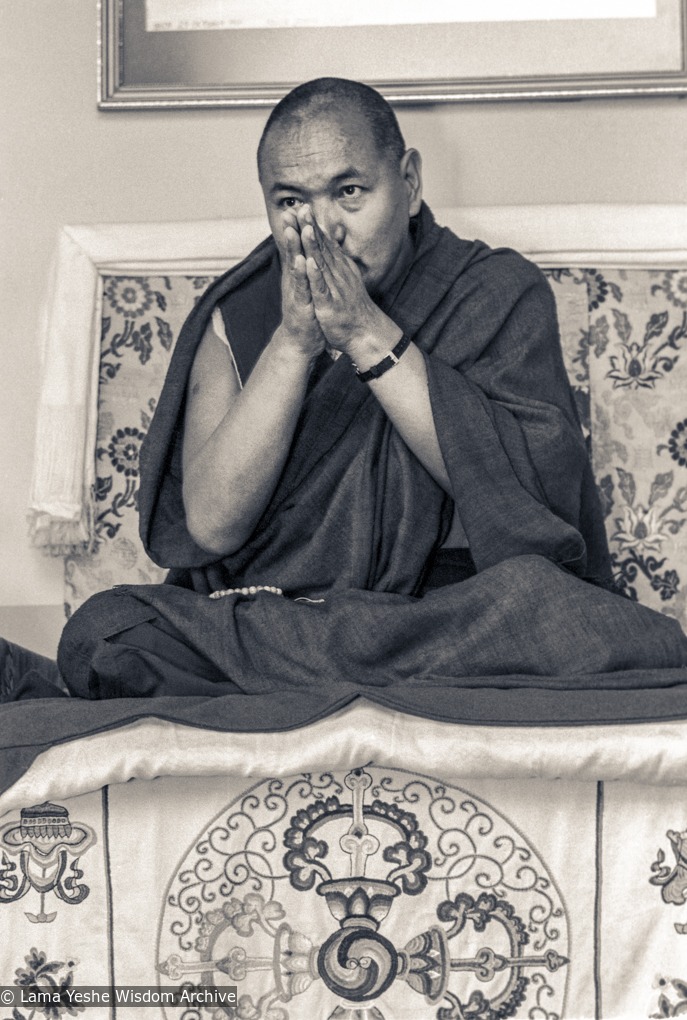
Lama Yeshe teaching at Manjushri Institute, England, 1979. Photo by Brian Beresford, courtesy of the Lama Yeshe Wisdom Archive.
In this excerpt from the teaching, “Refuge is a State of Mind” given at Chenrezig Institute, Eudlo, Australia, on September 12, 1979, Lama Yeshe discusses many aspects of Refuge to consider. This teaching is now published in the LYWA book: Knowledge-Wisdom: The Peaceful Path to Liberation:
The lamrim shows exactly, logically, scientifically that human happiness and joy do not depend on material conditions. You should understand this clean clear and determine that that is reality. Then you will not be upset when you don’t get presents or chocolate or when people don’t pay attention to you. Otherwise, small things always upset you and small things make you dissatisfied. The over-extreme expectation of getting things from the external world makes problems. So, taking refuge in Buddhadharma instead is really worthwhile.
Some people feel that by taking refuge, “I have to remember my lama’s nose, my lama’s head.” That is not necessary. When you take refuge it is not necessary for you to always remember your lama’s nose. Others may feel, “I have to go to the temple every day,” or “I have to say Buddha, Buddha, Dharma, Dharma, Sangha, Sangha, Buddha, Buddha, Dharma, Dharma, Sangha, Sangha every day—if I forget to say those words, I am completely guilty, I am not acting correctly for one who has taken refuge.” It’s not that way either; that, too, is a misunderstanding.
We are not trying to get the Western mind to copy these aspects of Buddhist culture. Westerners should understand that taking refuge is a state of mind. It doesn’t matter whether you are in a plane, in the subway, in a train, in a bathroom or wherever—somehow, you recognize your buddha potential and rely on that inner wisdom to stop the problems of everyday life. Furthermore, you understand that you can deal with these through meditation, through intellectual thinking, or through enacting the six perfections. From my point of view, that kind of thing is good enough, and if you are really taking refuge you don’t need to say the word “Buddha” even once.
And also, ordinarily, when you are depressed, you can ask Buddha for help. By recognizing Buddha’s unlimited wisdom and universal compassion, it helps psychologically. When you remember his universal compassion, when you think of his universal wisdom, somehow, from your side, you open up a little bit. In other words, you just think about the reality of the whole world; you look at what’s going on in the whole world: what’s going on in Africa? What’s going on in America? What’s going on in India? What’s going on? Just by thinking about all the different conditions of human existence, you find, “Somehow, I’m not too bad, I’m not too bad.” So that’s the way of opening up, that’s what being open means. When your mind opens to such a profound universal object, it has space.
It’s the same thing when you remember Buddha’s unlimited compassion, unlimited wisdom and unlimited power. Thus, it is easy to see that taking refuge is not something where you are just relying on words. You can read the whole expert from this teaching on the Lama Yeshe Wisdom Archive.
This talk, given by Lama Yeshe at Chenrezig Institute, Eudlo, Australia, on September 12, 1979, has been published in the LYWA book Knowledge-Wisdom: The Peaceful Path to Liberation. Edited by Nicholas Ribush. All of the chapters are available to read online.
You can find additional teachings, discourses, and advice from Lama Yeshe and Lama Zopa Rinpoche on the Lama Yeshe Wisdom Archive website.
Subscribe to the LYWA monthly e-letter and keep up with the latest news and publication information.
Foundation for the Preservation of Mahayana Tradition (FPMT), is a Tibetan Buddhist organization dedicated to the transmission of the Mahayana Buddhist tradition and values worldwide through teaching, meditation and community service.
- Tagged: advice from lama yeshe, refuge
11
Lama Yeshe’s Wisdom: What is Dharma?
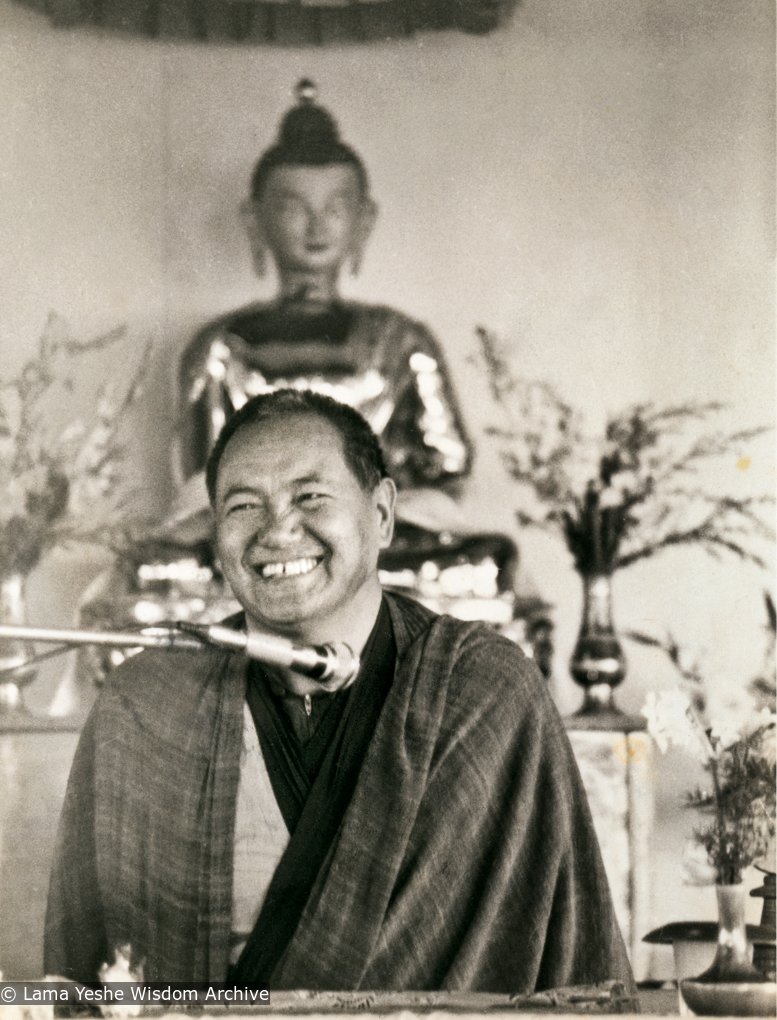
Lama Yeshe teaching at Chenrezig Institute, Australia,1979. Photo by Pearl Bailey (donor), courtesy of the Lama Yeshe Wisdom Archive.
In this excerpt from the teaching, “What is Dharma?” Lama Yeshe discusses the real meaning of Dharma and the nature of the mind in this discourse given at Chenrezig Institute, Eudlo, Australia, on September 8, 1979. This discourse is now published in the LYWA book: Knowledge-Wisdom: The Peaceful Path to Liberation.
Supposedly, all of us, including myself, should be Dharma practitioners, and here, the important things to know are what Dharma really is and how it should be practiced.
Generally, the word Dharma has many meanings, many different connotations. For example, there are various philosophical explanations, but we don’t need to get involved in those. Practically, now, what we are involved in is practicing Dharma.
First of all, it is very difficult to understand exactly what Dharma really means for each of us as individuals. The reason is that we have to understand to some extent the relationship between the Dharma and our mind, or consciousness. In order to understand that, we need to understand that the mind, or consciousness, has two characteristics.
I am sure you have heard the philosophy of relative nature, or character, and absolute nature, or character. The relative nature of the mind, or psyche, or consciousness, is clarity and perception: the clear energy that has the ability to perceive reality, to allow the reflection of the reality of all existence. That is what we call the mind. People who have studied Buddhist teachings on the primary consciousnesses and the fifty-one mental factors will have some understanding; for them this will be easy.
But what I want you to understand is that our mind is the clarity and clear perception that can reflect the reality of existence, that’s all. If you understand it in that way, the advantage is that when we talk about buddha potentiality, you can say, “Yes, we have buddha potential and can reach the same level as the Buddha.” We understand the relationship between the Buddha and ourselves.
Otherwise, most of the time, sentient beings have the tendency, or dualistic attitude, to think, “I am completely dirty and unclean, totally deluded and hopeless—sinful, negative, wrong, worthless.” Whether we are believers or nonbelievers, we human beings always have the tendency to identify ourselves in such a negative way. In other words, we are limited, like a passport identity. Our ego projects for each of us a very limited identity. The fact that we believe in and identify with such narrow, limited energy already begins to suffocate us. We are suffocating because we have a suffocating attitude. Please continue to read the full teaching.
This talk, given by Lama Yeshe at Chenrezig Institute, Eudlo, Australia, on September 8, 1979, has been published in the LYWA book Knowledge-Wisdom: The Peaceful Path to Liberation. Edited by Nicholas Ribush. All of the chapters are available to read online.
You can find additional teachings, discourses, and advice from Lama Yeshe and Lama Zopa Rinpoche on the Lama Yeshe Wisdom Archive website.
Subscribe to the LYWA monthly e-letter and keep up with the latest news and publication information.
Foundation for the Preservation of Mahayana Tradition (FPMT), is a Tibetan Buddhist organization dedicated to the transmission of the Mahayana Buddhist tradition and values worldwide through teaching, meditation and community service.
- Tagged: lama yeshe, lama yeshe advice
8
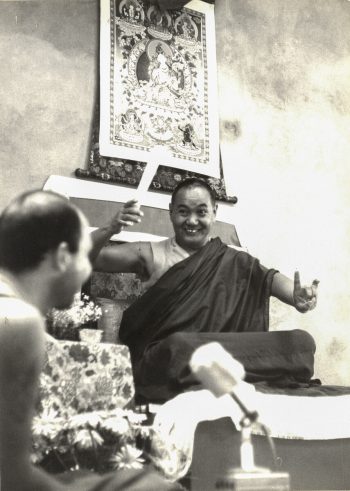
Lama Yeshe teaching at Istituto Lama Tzong Khapa, Italy, 1979. Photo courtesy of the Lama Yeshe Wisdom Archive.
The Lama Yeshe Wisdom Archives offers a growing index of teaching excerpts from Big Love: The Life and Teachings of Lama Yeshe. In addition to the fascinating historical narrative from students of Lama Yeshe, Big Love is also filled with Dharma teachings.
Here we share an excerpt from a teaching by Lama Yeshe on how to investigate the space-like nature of all phenomena at Istituto Lama Tzong Khapa, Pomaia, Italy, on July 12, 1979. This teaching is published in chapter 17 of Big Love:
For the next thirty minutes, just check up what you feel. I want you to meditate on your own experience. I don’t want you to think about Buddhism, lamrim, tantra, yoga, lama or any idea. Just watch; check up on whatever you’re experiencing.
Maybe you have pain. We generally feel the energy of pain as sort of concrete, but if you check up it is also like space energy, like light. I want you to just contemplate that experience, meditate on that. Or if you feel happy, check up in the same way. Just contemplate. Don’t think that pain is bad, pleasure is good. Don’t engage in such emotional reactions, good or bad. Just emphasize natural contemplation, concentration, without too much intellect.
Even if there is depression, just look at that depression in the mind. I want you to contemplate that depression, which is in the mind, not in the body. At a certain point, that pain becomes space; you become space. Pain becomes space; pleasure becomes space. You become space, like the sky. If you contemplate like that, without emotional involvement, eventually you can have this experience. And that is the time you should not be afraid. Just hold. Don’t worry; I don’t want you to worry. Just contemplate continuously without being afraid. And in that moment, you experience losing your ego.
Every sense object that we experience appears to us as a concrete entity. There is a kind of concreteness that appears from the object itself. Normally we say that whatever we perceive in the world is real. “Everything I see or hear or touch is true, true, true!” We never question this at all. But this is wrong.
So now we are checking philosophically. You might think that checking philosophically is difficult … right view, wrong view. It’s not difficult; it’s simple. Whatever appears to your eye, to your ear and so on … instead of accepting it, believing it, be skeptical. Don’t accept how things appear at face value. Be a little suspicious, a little bit “I’m not sure.” To find the right view, you don’t need to look at space, you don’t need to look at your lama’s face or at Buddha’s face. You need to look at the face of your normal way of looking at things, your normal view. If you observe your view you’ll see that the right view isn’t there. In other words, you find the wrong view in your normal way of looking at things. Please continue to read the full teaching on the Lama Yeshe Wisdom Archive.
This teaching was given at given at Istituto Lama Tzong Khapa, Pomaia, Italy, on July 12, 1979 and is published in chapter 17 of Big Love: The Life and Teachings of Lama Yeshe.
You can find additional teachings, discourses, and advice from Lama Yeshe and Lama Zopa Rinpoche on the Lama Yeshe Wisdom Archive website.
Subscribe to the LYWA monthly e-letter and keep up with the latest news and publication information.
- Tagged: big love, lama yeshe
16
Lama Yeshe’s Wisdom: Living in Awareness
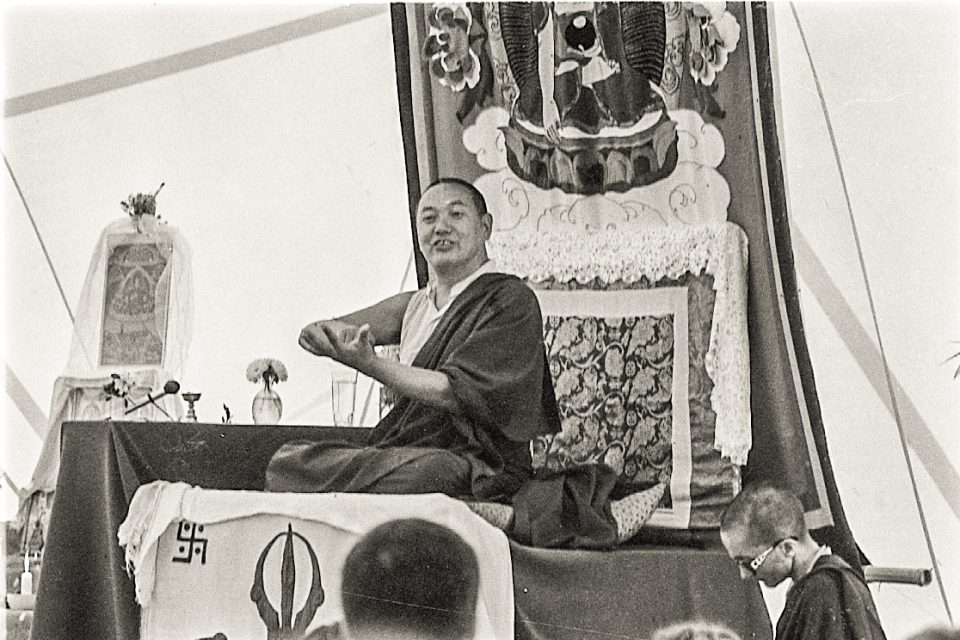
Lama Yeshe teaching in Ibiza, Spain, 1977. Photo by Francois Camus (donor), courtesy of the Lama Yeshe Wisdom Archive.
The Lama Yeshe Wisdom Archives offers a growing index of teaching excerpts from Big Love: The Life and Teachings of Lama Yeshe. In addition to the fascinating historical narrative from students of Lama Yeshe, Big Love is also filled with Dharma teachings. Here we share an excerpt from a teaching by Lama Yeshe on the importance of cultivating mindful awareness in our actions and a clear understanding of karma, in Ibiza, Spain, October 1977. This teaching is published in Chapter 16 of Big Love:
The lamrim actually teaches us that everything we see—on the television, the wind blowing, the movement of the ocean—all these are a teaching on karma. The lamrim teaches reality. Time is changing. Summer changes to autumn, autumn changes to winter and winter changes to spring. All these changes, all this movement shows the impermanent nature of reality. We should learn from these teachings that the world brings us constant change. In the same way that these things change, so do I. We haven’t yet understood this. We should understand that every movement that we see, every movement that exists in the entire world is showing you reality.
When we watch something on television, we see it as a fantasy. Instead of seeing it as presenting the evolution of cause and effect, we are shaking with fantasy and become even more deluded. Are we communicating? But if we have Dharma wisdom, when we watch movies or television, we see that these are showing us cause and effect in the evolution of samsara. Unfortunately, we aren’t generally able to see actual reality. We only see things in a polluted way, and so we become more deluded.
Every movement of karma has a reason. Every movement of karma is connected, is an evolutionary link. If you understand that, you understand karma. Your mind transforms, your body transforms, your nervous system transforms; they are all changing, changing, changing. You can see karma. And when you can see karma, then you are aware of your actions—what you are supposed to do, what you shouldn’t do. You have some control of your own mind. You become more discriminating with regard to your own behavior. Then it becomes the practice of Dharma. If you are unconscious about your own actions, if you don’t know what you are doing, then there is no way you can see what action brings what result. Not being able to see clean clear which results come from which attitude or action is actually a cause of your continuing ignorance. That is not Dharma practice.
Being mindfully aware of all your own actions throughout all the hours of the day, from the time you get up in the morning until you go to sleep—that is even more profound than doing some kind of meditation in the morning. The reason I’m saying this is that Western people are so interested in meditation. They love meditation, love to talk about meditation, but they don’t love it when Lama explains karma. Karma is strong, strong. “Karma is … well … that’s too heavy for us!” But our body, speech and mind are heavy already. It’s not your lama who makes them heavy. They are already heavy. This is why understanding karma is very important. Meditation is OK. But even if you are unable to meditate it’s all right. My meditation is that as much as possible I try to be aware of my own actions. I dedicate my day as much as possible to other people. Whatever I am involved in I try to have loving kindness and be sympathetic to others and I try not to take advantage of others as much as possible. This is my meditation. I observe my own body and speech; this is my meditation. Actually, that is more precise and realistic than, “Oh, I’m meditating on tantra ….”
This is a very simple thing. Today, even though we are here, our mind is not actually living here. Already we are thinking, “After the course I’ll … blah, blah, da da da ….” Our body is here but our mind is already in the future, after the course, not living in the present, not living in the moment. We never pay full attention to each other in this present moment. For example, while I’m talking to you people, my mind is thinking of Tibet. I’m not with you. This is wrong! Each day, when you get up in the morning, remember, “Today I am alive. How fortunate that I am alive today. I can do much better than dogs or chickens because I have the power of being human. I have better understanding. So, as much as possible today I’ll be aware and keep my body, speech and mind clean clear. I will communicate a good vibration to sentient beings and dedicate my life to reaching the highest destination—enlightenment.”
By generating this dedicated attitude in the morning, by the power of your mind you bring great space to your day. In this way the power of your mind keeps you from becoming angry. By living in an awareness of the present moment, it brings a kind of total relaxation, rather than fooling yourself.
Lama Yeshe gave this teaching in Ibiza, Spain, October 1977. From Chapter 16 of Big Love: The Life and Teachings of Lama Yeshe.
You can find additional teachings, discourses, and advice from Lama Yeshe and Lama Zopa Rinpoche on the Lama Yeshe Wisdom Archive website.
Subscribe to the LYWA monthly e-letter and keep up with the latest news and publication information.
- Tagged: big love, lama yeshe
20
Lama Yeshe’s Wisdom: A Simple Explanation of Karma
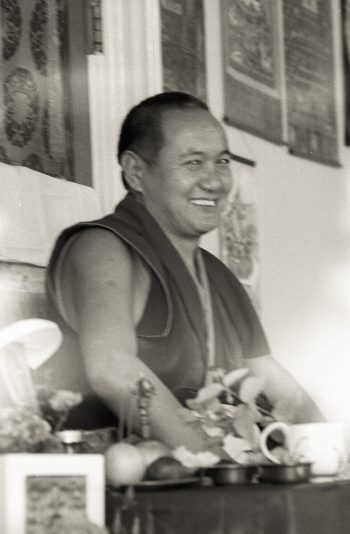
Lama Yeshe teaching at Manjushri Institute, England, 1976. Photo courtesy of the Lama Yeshe Wisdom Archive.
The Lama Yeshe Wisdom Archives offers a growing index of teaching excerpts from Big Love: The Life and Teachings of Lama Yeshe. In addition to the fascinating historical narrative from students of Lama Yeshe, Big Love is also filled with Dharma teachings. Here we share an excerpt from, “A Simple Explanation of Karma” from Chapter 14 of Big Love:
You can explain karma in many different ways. For example, it can be explained academically, with many divisions and analytical points of view. But right now I am going to give just a simple explanation.
Karma means action; actions of body, speech and mind are karma. For example, we have just recited, “I take refuge in Buddha, Dharma, and Sangha; I will follow the Dharma.” But if we are not conscious in our everyday actions of body, speech and mind I think it is difficult to really take refuge.
Taking refuge cannot solve your problems if you are not aware of your own actions. Even though you believe “Buddha is fantastic; Dharma is fantastically pure; Sangha is fantastic. They are perfect; I have no doubts,” that is not enough. It is not enough to say, “OK, I understand from meditation, books and lamas that Buddhadharma is perfectly clean clear. I know now that this is my path.” If you live that way rather than being aware of your own actions, refuge cannot solve your problems. Real refuge is saying and doing things according to the motivation of refuge in your mind, and that is karma.
Karma means that you act in a certain way with a certain motivation and some effect arises within you. Karma can be positive or negative. Actions that bring a positive reaction are called morality; actions that bring a negative reaction are called immorality. Whatever action—or we can call it energy—of body, speech or mind that brings confusion, restlessness, sorrow or suffering is immoral. So, as much as possible, we should try to understand Lord Buddha’s teachings, which say that certain actions are moral and certain actions are immoral because they bring good or bad reactions respectively.
Understanding this, in your everyday life you should try to make your actions as positive as you can. Try to understand, “If I think this way and act this way, what kind of result will it bring?” Knowing this is very important. Also, karma is not something that you just believe. Your entire energy since you were born has been related to karma. The existence of karma is not dependent on whether you believe it or not.
For example, maybe you say, “I don’t believe in karma. I don’t believe in anything. There is no such thing as karma making me happy or unhappy.” No matter how much you are against it, your entire being, your saying this and thinking that—it is all karma. No matter how much a person may be against Lord Buddha’s idea … it doesn’t matter. The entire person, both psychologically and physically, who is tick, tick, ticking like a watch—all that is karma. Therefore, karma is just the energy of your body, speech and mind. The human body, speech and mind are karma.
The meaning of karma includes cause and effect. Your entire physical and mental energy, everything is reacting and producing other actions, no matter whether you believe it or not. Some Western people think, “Well, if I am Buddhist and I believe Lord Buddha’s idea, then I have to be careful; if I am not careful I will get bad karma. But if I do not believe, it doesn’t matter.”
Many Western people think like this; in my life I have heard some people say this. It is not like that. Karma does not depend on whether you believe it or not. It doesn’t matter if you believe; it doesn’t matter if you don’t believe; it doesn’t matter even if you reject. Karma is talking about natural scientific law—that’s all. Natural scientific law—how can you reject that? It is not something Lord Buddha made up.
Also, there is some confusion around Eastern words. The word “karma” is Sanskrit. When one says “karma,” you say, “Oh, karma is Eastern stuff.” You cannot say that. All of you is karma. You are karma; you cannot escape from karma. It does not matter if you follow another religion, if you are a Hindu, if you are a Christian, if you are a believer or a non-believer, you are completely immersed in karma.
That is why karma is very heavy. You cannot say, “I don’t believe in suffering.” It does not matter whether you believe you are suffering or not—you are suffering. Your suffering is not dependent on whether you believe in it or not.
Now, you can see through your own meditation experience how the mind is continually circling around—whooooshhhhhh. You cannot stop your mind from running around—one thought, then another thought, and another thought, and another … phew! Incredible! This is karma, the uncontrolled thoughts running, running like a watch. Without understanding the activity of our body, speech and mind we will not understand how to generate a positive or a negative lifestyle. Even though we have tremendous belief that “Buddhadharma is my way,” we are still joking.
The simple way to live positively is to examine the everyday actions of your own body, speech and mind. As much as possible be aware; what we call morality is putting the energy of body, speech and mind in a positive direction. But in the West, morality and immorality have religious connotations. There are some funny ideas, such as the belief that morality is something made up by religious people. No! Morality is not merely a religious idea; it is not some philosophical creation. Morality is about nature.
Scientists explain natural things—organic, inorganic, the evolution of human beings, fish and monkeys. This is all taught at school and you learn these things. From Lord Buddha’s point of view, karma is closer to the things you learn at school. In school they try to teach you as scientifically as possible: “This is exactly like this, then this comes, then this, then that,” and so on, the mathematical way. Karma is similar.
Actually, if you are aware of how your own body, speech and mind are running, the evolution of your everyday life is similar to what you learned at school. When you understand karma you will see how greatly effective just one small action can be. For example, when Lord Buddha once explained karma, he used a bodhi tree seed as an example. Do you know the Bodhi Tree in Bodhgaya? It is huge, isn’t it? He took a seed of the Bodhi Tree and said that by putting that tiny seed into the ground, the result would be a huge tree that can give shelter to five hundred bullock carts. That was Lord Buddha’s example: a small seed can produce a huge plant. It is the same thing with karma. Especially the psychological effect, which is much greater than the external one.
In the West, some people think that karma is something simple, whereas meditation is a profound and unusual contemplation where you become very high and feel, “I’m happy …” They think that is fantastic. Actually, according to the lamrim, meditation is not the most important thing. What is extremely important is to maintain awareness of your everyday life actions. Be aware of your own actions and put your actions on the right track. Then you will begin to experience an incredible effect.
From Chapter 14 of Big Love: The Life and Teachings of Lama Yeshe.
You can find additional teachings, discourses, and advice from Lama Yeshe and Lama Zopa Rinpoche on the Lama Yeshe Wisdom Archive website.
Subscribe to the LYWA monthly e-letter and keep up with the latest news and ordering information.
- Tagged: big love, karma, lama yeshe
20
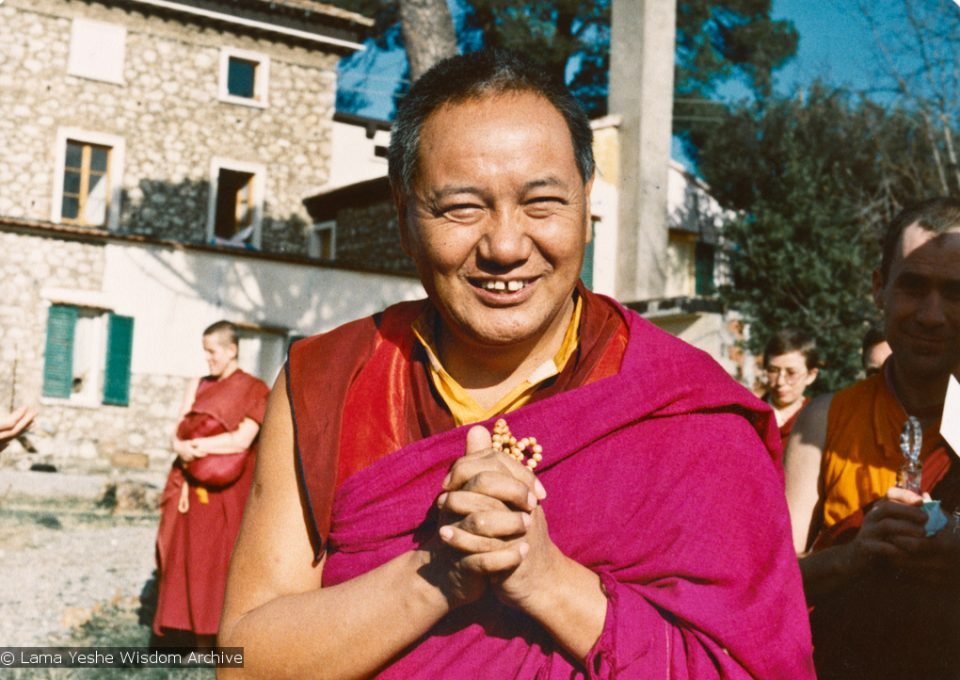
Lama Yeshe at Istituto Lama Tzong Khapa, Italy, 1983. Photo courtesy Lama Yeshe Wisdom Archive, donated by Merry Colony.
In 2025, Lama Yeshe would have reached the age of 90 years. To honor his profound legacy, Istituto Lama Tzong Khapa (ILTK), Italy, invited his students from across the globe to share their treasured memories and life-changing teachings with present and future generations. A special puja was held on May 15 at ILTK celebrating what would have been Lama’s birthday.
Carlota Pinhero shares the story:
Lama Yeshe
May 15, 2025, marked what would have been the 90th birthday of Lama Thubten Yeshe. Istituto Lama Tzong Khapa gathered to celebrate his impact on countless lives. With profound gratitude for his jewel-like teachings available in these challenging times, we reaffirm our commitment to manifest Lama Yeshe’s vision through our actions and practice. He consistently emphasized cultivating a sense of family within the FPMT community. Honoring this wish, we gathered as part of this international family united in dedication to the Dharma and the ultimate welfare of all sentient beings.
Lama Yeshe was the beginning of the transformation of the minds of many westerners; the eye-opening key to the freedom that is possible to achieve in ourselves; the pointer to how all the suffering we’re experiencing is created by nothing but our minds. As his previous incarnation, abbess Achè Jampa, prayed over and over again “May I be able to bring the Dharma to those who have never met it and who live in suffering, their wisdom eyes are blinded by the darkness of ignorance.” And that is what Lama did! Lama Yeshe lived in a time of cultural revolutions and joked about his own revolution, the “Dharma Cultural Revolution.” He inspired and continues to inspire countless people to truly investigate what it means to be a human being.
As we have been conducting the interviews with his earliest students to celebrate 90 years since his birth, new ways of viewing reality have been unfolding, just by merely listening to Lama’s words through the mouths of those who were once very close to him, just as if he was here speaking himself. The way Lama shaped people’s lives and completely changed them from very negative states to very happy ones, is unique in this world. Even those new to Buddhism can feel his influence so present here in the center. Lama Yeshe knew how to deeply love each individual, listening attentively, healing without judgment and even smiling at the shadows of the mind. His “Big Love” gave new light to those blinded by ignorance. His faith in human potential brought many students to believe in themselves and bring a positive impact to the world.
Community Celebration of the 90th Anniversary of Lama Yeshe’s Birth
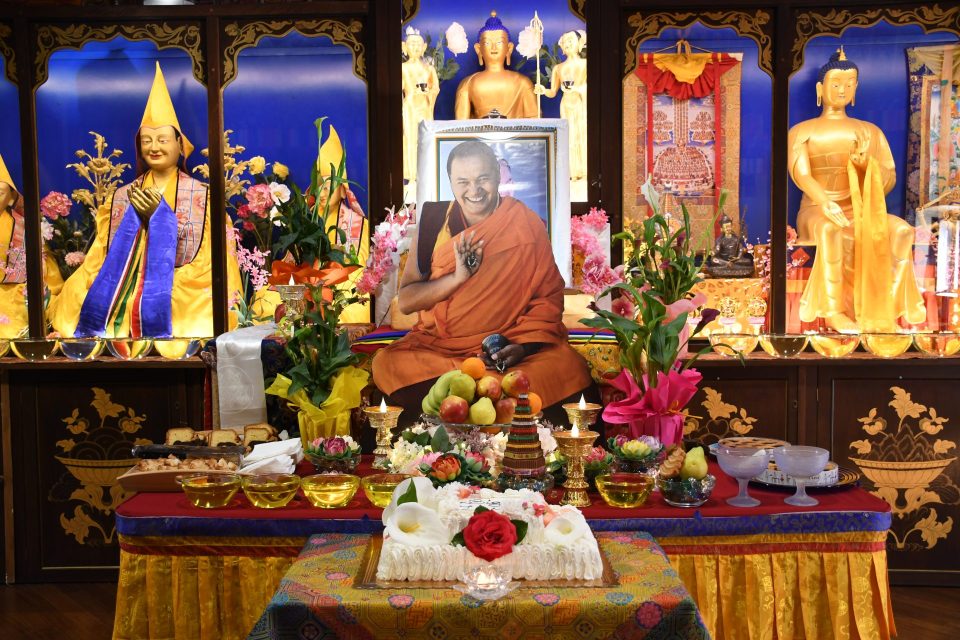
The altar at ILTK for the Lama Yeshe ninetieth birthday celebration. Photo courtesy of ILTK.
Cleaning Lama Yeshe’s Stupa
As the sun reached its zenith, a small group of us gathered in the gardens of ILTK, around Lama Yeshe’s sacred stupa, built many years ago as a testament to his enduring presence. Volunteers, intrigued by our festive environment, would go by and join us. This stupa has been a silent witness to the full spectrum of human emotion; from the grief of his passing, to the excitement of a reincarnation, and now hundreds of people each week come to circumambulate it, walk their pets, or encounter the Dharma for the first time during retreats.

Geshe Lhundrup guiding and cleaning Lama Yeshe’s Stupa, ILTK, Photo courtesy of ILTK.
With a screwdriver in one hand and silicone in the other, clothes and sponges at the ready, we began chanting mantras while spending the next four hours meticulously cleaning every sacred detail of the stupa—polishing the ornate silver that frames Lama Yeshe’s image and the Buddha seated within, removing the weathered cloths and offering it fresh khatas and flowers. Geshe Lhundrup, a monk from Kopan now resident at ILTK, and Thubten Sherab, raised by Lama Yeshe and Lama Zopa Rinpoche, spent the day guiding us on the best way to do this. The sun was shining the whole afternoon, and the environment felt exactly like what we are here to do in this life: work with intention, remain aware of our actions, rejoice and help each other in whatever ways we can.
There is something special about coming together as a community to honor one’s teacher, to honor the legacy that allows us to be here today, working on our afflictions and, together, discovering how to cultivate happy minds and a happy family. This was Lama’s wish. In 1978, visiting ILTK, he said, “Each one of us can become a disaster when we go through difficult times, so we must try to help each other.”
Guru Puja
The day culminated in a special Guru Puja with a beautiful cake inscribed with “Big Love” at its center, offered by ILTK president, Lucia Landi, and director, Valerio Tallarico. The gompa was filled with practitioners, including some of the direct students of Lama Yeshe who shaped the center into what it is today. For him, ILTK had the function of being a refuge: “It has to be friendly, because everything is dedicated to sentient beings.”
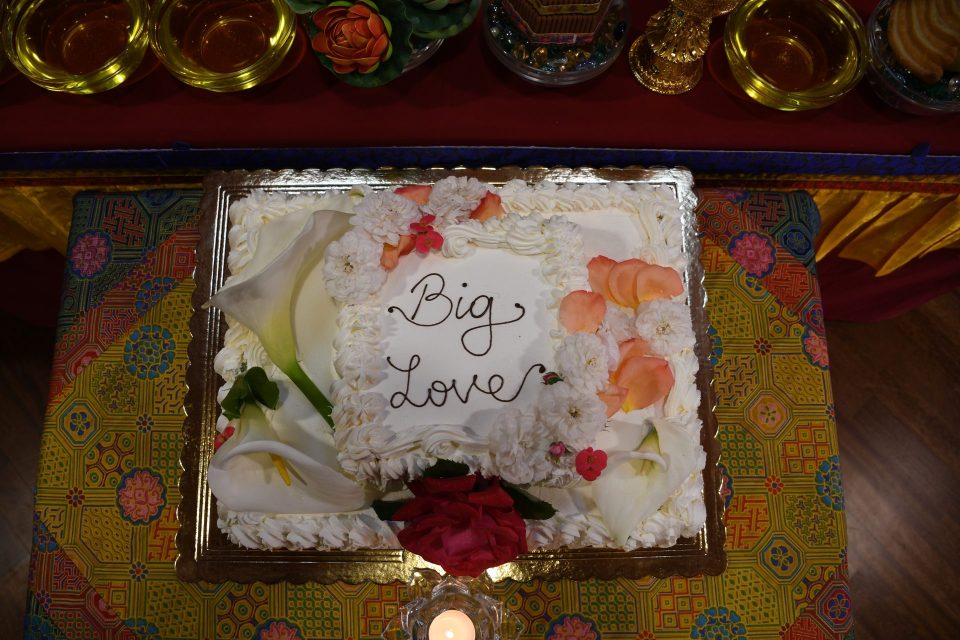
Big Love cake offered during the puja. Photo courtesy of ILTK.
The puja was conducted by Geshe Gelek and, in the end, some of Lama’s first students shared memories and funny stories, among them, Massimo Corona, founder of the Institute, former executive director of FPMT International Office, and former publisher of Mandala magazine; and Susanna Parodi, who, in the words of Lama, was, “the first lady on this earth to become Italian Mahayana Buddhist nun.” Voices united in chanting and in gratitude as we spoke about the true source of it all: The boundless compassion of our precious Lama.
Lama Yeshe joked, “There are three types of Buddhism: Hinayana, Mahayana, and Italiana!” He made this comment due to the unique passion and distinct attitude of the first Italian students. It is also thanks to this dedication that the Institute is one of the biggest in Europe and one of the doors through which the Dharma continues to spread around the world.
Direct Students Interviews
Throughout 2025 ILTK will be interviewing Lama’s direct students to share how his teachings impacted on their lives through short video. These interviews will be treasured and shared through the Institute’s social channels and with the Lama Yeshe Wisdom Archive.
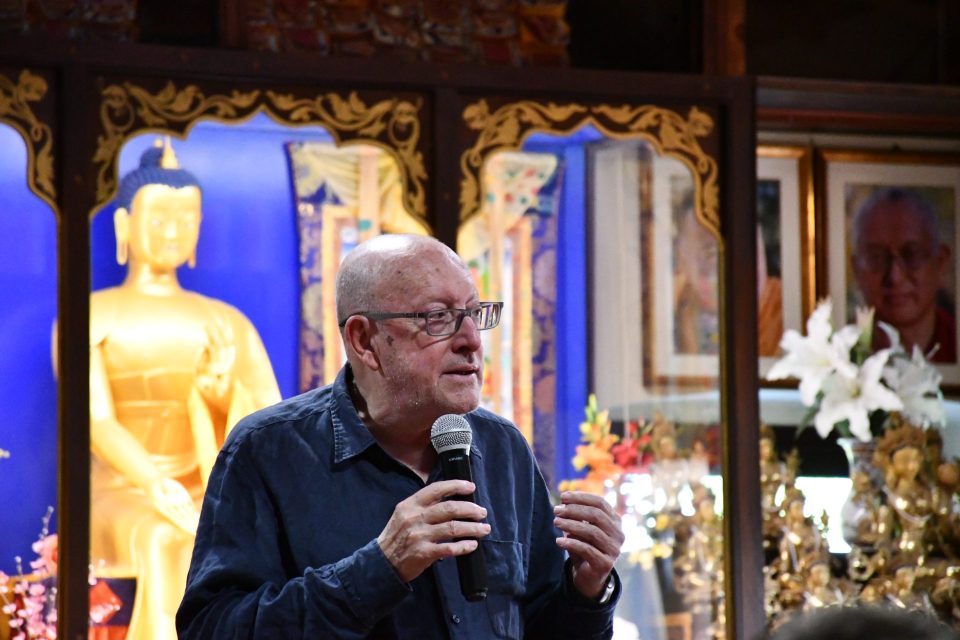
Massimo Corona speaking about Lama Yeshe and the origins of ILTK. Photo courtesy of ILTK.
Listening to the stories of those who had their minds completely transformed by Lama Yeshe and feeling this strong sense of family, devotion and, above all, deep gratitude, is deeply inspiring and has sparked the wish of keeping his legacy in any way possible. The way future generations can, especially now, benefit from his teachings, his timeless wisdom and compassion, is inconceivable. This is what the path to enlightenment is, caring for our own minds and also caring for this rare family that we build through our devotion to the Dharma and the lamas, from the single intention of leading all beings to a state free of suffering.
If you wish to help keep Lama’s legacy alive for the future generations, and were fortunate enough to have known Lama Yeshe, please consider taking part in the project 90 Students for 90 Years. If interested, please contact ILTK directly. The short video interview series will continue through 2025.
All quotes shared here are from Big Love: The Life and Teachings of Lama Yeshe. With grateful thanks to Carlota Pinhero and Fabiana Lotito for this story.
Foundation for the Preservation of Mahayana Tradition (FPMT), is a Tibetan Buddhist organization dedicated to the transmission of the Mahayana Buddhist tradition and values worldwide through teaching, meditation and community service.
- Tagged: lama yeshe
16
Lama Yeshe’s Wisdom: Defeating the Eight Worldly Dharmas
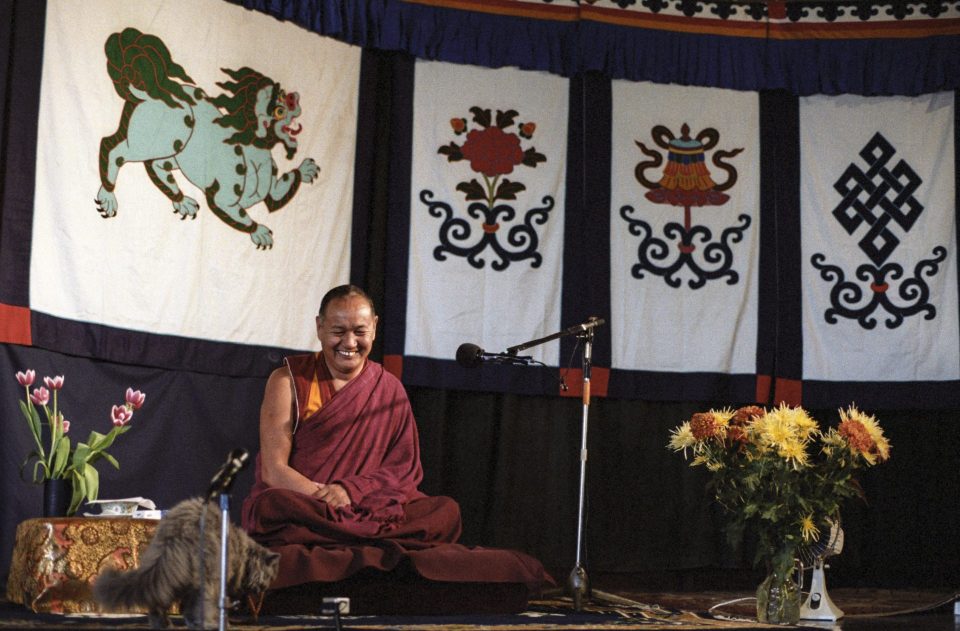
Lama Yeshe teaching at Kosmos Centre, Amsterdam, 1980. Jan-Paul Kool (photographer) Photo courtesy of the Lama Yeshe Wisdom Archive.
Clean-Clear: Refuge, Bodhicitta and the Nature of the Mind is the second volume in a series of Lama Yeshe’s collected teachings, forthcoming in May 2025 from the Lama Yeshe Wisdom Archive. This book contains introductory teachings given in England in 1976 and Holland in 1980. Compiled and edited by Nick Ribush.
Here we share an excerpt of Lama Yeshe’s teaching from Chapter 13 of this book, Defeating the Eight Worldly Dharmas:
The attitude behind the eight worldly dharmas, or phenomena, is a symptom of ignorance and ego and we have to recognize it as a negative motivation. For example, if you have the attitude that receiving a present is a source of pleasure and not receiving one is a cause of unhappiness, that’s not good. That attitude is a symptom of ego.
First of all, this attitude does not understand what is a gift and what is not. It functions at a very gross level. You don’t understand the broad view that the gift of other sentient beings is profound. If you think that giving chocolate is the only way to interpret giving—if you’re not giving chocolate, you’re not giving—your view is extremely narrow, and that’s a problem.
Another of the eight worldly dharmas is being attached to pleasant feelings and averse to unpleasant ones. That’s not good either. For a start, the way in which you interpret pleasant and unpleasant is completely relative; it depends. For example, one person considers meditating to be like going to a nightclub or the beach and finds it really enjoyable, while another considers it to be like being in prison and completely miserable. So, finding certain situations pleasant or unpleasant depends on your attitude.
Secondly, taking responsibility for your own liberation and enlightenment is not an easy job. It requires much effort. To demonstrate this, Shakyamuni himself spent six years in indestructible single-pointed meditation without food or other necessities in order to attain his goal. That’s not to say you should punish yourself in that way, but it’s a matter of putting right livelihood into the right channel, skillfully putting your body, speech and mind in the right direction, from peaceful environment to peaceful environment, which is, in fact, the path to enlightenment.
I say that following the path to enlightenment is not an easy job because our wrong conception mind, our grasping attitude, always overwhelms, interrupts and interferes with our efforts, and dealing with all this disruption can be difficult. So we should expect to encounter obstacles when trying to follow the path.
Nevertheless, the Buddhist interpretation of negotiating the path to enlightenment is not that it should be a miserable experience. We should not think, “I’m a religious person, therefore I should suffer; I’m a religious person, therefore I should not have plenty of bread and butter and should feel guilty if I do. Look at the people in Africa; they don’t even have water.” That sort of ridiculous thinking just makes you depressed. Also, it’s not right. You should not make yourself emotionally irritated, confused or guilty. That simply disturbs your tranquility and peace of mind. Read more of Chapter 13, Defeating the Eight Worldly Dharmas.
From Clean-Clear: Refuge, Bodhicitta and the Nature of the Mind, the second volume in a series of Lama Yeshe’s collected teachings containing introductory teachings given in England in 1976 and Holland in 1980. Compiled and edited by Nick Ribush.
You can find additional teachings, discourses, and advice from Lama Yeshe and Lama Zopa Rinpoche on the Lama Yeshe Wisdom Archive website.
Subscribe to the LYWA monthly e-letter and keep up with the latest news and ordering information.
Foundation for the Preservation of Mahayana Tradition (FPMT), is a Tibetan Buddhist organization dedicated to the transmission of the Mahayana Buddhist tradition and values worldwide through teaching, meditation and community service.
- Tagged: advice from lama yeshe, lama yeshe
28
Lama Yeshe’s Wisdom: Meditation is Action
Clean-Clear: Refuge, Bodhicitta and the Nature of the Mind is the second volume in a series of Lama Yeshe’s collected teachings, forthcoming in May 2025 from the Lama Yeshe Wisdom Archive. This book contains introductory teachings given in England in 1976 and Holland in 1980. Compiled and edited by Nick Ribush.
Here we share an excerpt of Lama Yeshe’s teaching from Chapter 1 of this book, Mind and Meditation:
Meditation is Action
If you cultivate your mind in meditation, it becomes sharp and clean clear and you can easily see your false conceptions. This is extremely difficult to do when you are deeply submerged in hallucination, just as it’s extremely difficult to surface when you’re trapped deep in the ocean. At the beginning, when you’re full of wrong conceptions and garbage thoughts, it’s hard to distinguish between right and wrong. Extremely difficult. Therefore, meditation is so worthwhile. Its result is that it integrates your mind and allows you to understand your own actions, which mostly arise from misconceptions and lead you into a restless state of mind.
Through meditation you can also see your great potential and understand that there’s no value in just living for food and clothing. It’s so sad to see people living only for food and clothing, ignoring their great potential. That’s incredibly sad, isn’t it? Living for such small temporal pleasures, which have no real value and do not last. Sometimes, if we really check up, we’re too much; it’s incredible.
What we need to do is to compare the worldly pleasures that our wrong conceptions believe will make us happy with the benefits of meditation. In the West we have hundreds, even thousands, of ideas of what makes us happy, not just food and clothing. Look at supermarket shelves. There are so many ideas. Most of them are wrong conceptions. Through meditation you can discover those temporal objects have little value; actually, no value. I don’t mean you should completely reject them. Don’t reject them, but if you strongly desire them and put too much energy into them, it’s just not worth the effort. Especially when it comes to material objects, which are so unreliable. When you need them, they’re not there; when you don’t, they are. Sometimes they’re there, sometimes they’re not.
Consider medicines, for example. They are there to help us, to support and sustain life, but we can never be sure whether they’ll destroy our life or preserve it. It’s not certain. Through meditation, however, we can discover joy and the everlasting, peaceful state of mind, and that understanding can last forever—from this life to the next and to all our future lives. By comparison, material things can disappear in a flash, and at the time of death we leave everything behind. Not only that; we die with great attachment to our material possessions, and that brings us much harm. It’s not the material objects that harm us but our clinging to and grasping at them. During our life we grasp at this, we grasp at that, building up our attachment more and more, so that when we die, our grasping is incredibly strong and very difficult to release. During our lifetime, our desire wants more and more, such that we build up more and more superstition, which makes us more restless, more confused, more foggy and more ignorant. Therefore, actualizing meditation is really worthwhile.
If you don’t contrast material things with meditation you won’t understand how much more worthwhile the results of meditation are compared with those of the desires of the sense world. If you don’t know that, you won’t have much energy for meditation. Being unsure, you won’t see that sitting down to meditate is of much greater value than running out for chocolate. Your attraction to chocolate will be stronger than your desire for meditation. It’s obvious.
I’m not joking when I talk this way. I’m saying “chocolate,” but I’m referring to the incredibly overpowering Western vibration for sense pleasures. It’s all so exaggerated, which just makes life much more difficult for Western people. So much clinging. I can see that. But at the same time, you people are very intelligent; you can see how shopkeepers and television advertisers in the West understand people’s psychology. Ask yourself, “Why are they doing this? Why are they doing that?” They’re appealing to people’s superstitions and delusions. You can see. Maybe you think I’m exaggerating but check up for yourselves. That is the really important point. Read more of Chapter 1: Mind and Meditation.
From Clean-Clear: Refuge, Bodhicitta and the Nature of the Mind, the second volume in a series of Lama Yeshe’s collected teachings containing introductory teachings given in England in 1976 and Holland in 1980. Compiled and edited by Nick Ribush.
You can find additional teachings, discourses, and advice from Lama Yeshe and Lama Zopa Rinpoche on the Lama Yeshe Wisdom Archive website.
Subscribe to the LYWA monthly e-letter and keep up with the latest news and ordering information.
Foundation for the Preservation of Mahayana Tradition (FPMT), is a Tibetan Buddhist organization dedicated to the transmission of the Mahayana Buddhist tradition and values worldwide through teaching, meditation and community service.
- Tagged: advice from lama yeshe
- Home
- News/Media
- Study & Practice
- About FPMT Education Services
- Latest News
- Programs
- New to Buddhism?
- Buddhist Mind Science: Activating Your Potential
- Heart Advice for Death and Dying
- Discovering Buddhism
- Living in the Path
- Exploring Buddhism
- FPMT Basic Program
- FPMT Masters Program
- FPMT In-Depth Meditation Training
- Maitripa College
- Lotsawa Rinchen Zangpo Translator Program
- Universal Education for Compassion & Wisdom
- Online Learning Center
- Prayers & Practice Materials
- Overview of Prayers & Practices
- Full Catalogue of Prayers & Practice Materials
- Explore Popular Topics
- Benefiting Animals
- Chenrezig Resources
- Death & Dying Resources
- Lama Chopa (Guru Puja)
- Lama Zopa Rinpoche: Compendium of Precious Instructions
- Lama Zopa Rinpoche: Life Practice Advice
- Lama Zopa Rinpoche Practice Series
- Lamrim Resources
- Mantras
- Prayer Book Updates
- Purification Practices
- Sutras
- Thought Transformation (Lojong)
- Audio Materials
- Dharma Dates – Tibetan Calendar
- Translation Services
- Publishing Services
- Teachings and Advice
- Find Teachings and Advice
- Lama Zopa Rinpoche Advice Page
- Lama Zopa Rinpoche: Compendium of Precious Instructions
- Lama Zopa Rinpoche Video Teachings
- ༧སྐྱབས་རྗེ་བཟོད་པ་རིན་པོ་ཆེ་མཆོག་ནས་སྩལ་བའི་བཀའ་སློབ་བརྙན་འཕྲིན།
- Podcasts
- Lama Yeshe Wisdom Archive
- Buddhism FAQ
- Dharma for Young People
- Resources on Holy Objects
- Ways to Offer Support
- Centers
- Affiliates Area
- Teachers
- Projects
- Charitable Projects
- Make a Donation
- Applying for Grants
- News about Projects
- Other Projects within FPMT
- Support International Office
- Projects Photo Galleries
- Give Where Most Needed
- FPMT
- Shop
Translate*
*powered by Google TranslateTranslation of pages on fpmt.org is performed by Google Translate, a third party service which FPMT has no control over. The service provides automated computer translations that are only an approximation of the websites' original content. The translations should not be considered exact and only used as a rough guide.If your path teaches you to act and exert yourself correctly and leads to spiritual realizations such as love, compassion and wisdom then obviously it’s worthwhile.


